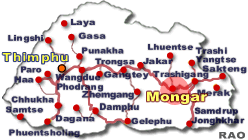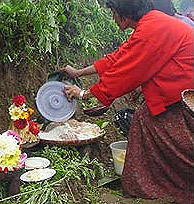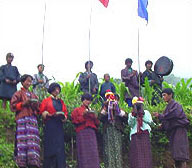|
The
lha festival: A dying Bon tradition
|
 |
Bhutan's
Culture Festivals |
|
 |
Bhutan Information |
|
|
|
 |
|
The
festival, as it was celebrated
|
 |
The
celebrations begin a month preceding the actual lha , with the Hagtshe
(early date), during which sang (incense) and tshog (banquet) were offered
on the rooftop of the host's house. It was believed that failure to make
offerings at this time resulted in the destruction of crops by stormy winds.
On
the first day of the sixth month, the tsawa made machhang by brewing |
 |
Tshog offering on altar/terrace at Halong 10
drey of wheat, and five drey of wheat ground into flour to make torma.
The people recited verses of wayo as wheat was poured into a cauldron of
boiling water, and again when yeast was mixed. During this moment, they
considered it inauspicious if a person from a house where there is a case
of sickness, birth, death or marriage appeared.
On
the fifth day, gazang chhang (gazing drink), necessary for offerings during
the lha festival, was made from six drey of wheat contributed by the host.
|
Early
on the ninth day, a man each from the Thogpa and Wogpa households went
to the other side of Phrang Phrangla, a mountain overlooking Gortshom,
to collect branches of wangshing.
Upon
reaching the mountain summit with these items, they recited the verses
of wayo aloud, to signal the villagers not to go to work in their fields
for the day. Known as lan, this restriction imposed on farm work was enforced
for the next few days, and the farmers keep a stock of vegetables to last
them for this period. Halfway home, they cut down three tall and slender
bamboos that were later installed as flagpoles.
|
Bon
Traditions
|
 |
The
Lha Bon and tsawa awaited the return of the sang collectors at the tsawa's
house. Upon hearing wayo sung by the two men from the mountain top, the Lha
Bon (who holds the middle of the lid) and the tsawa (who hold either
side) opened the machhang pot. The absence of any depression in the
brew indicated good luck for the community, while depression foreshadowed
misfortune. The two men went to a small clearing below a towering cypress
tree above Gortshom village. Before their arrival, the tsawa made two or
three small terraces as altar for the celebration.
A
small oak tree, erected at the side of the central terrace, had three-pronged
branches bound with a creeper that created a nest where offerings were
placed. The two men unloaded sang at the Halong, and took the bamboos to
the tsawa; they give fir branches, to be burnt during the tsen choed
(offering to Tsen deity) in the second month, to every household. In
return, they were offered chhang (drinks). This tradition of visiting
every household and drinking was popularly called chhangkor (drinks-circuit).
As
a symbolic gesture of receiving the lha home, the Lha Bon performed a ritual
at the Halong and then returned to the tsawa's house. In the evening, a
drey of paddy was placed over a bakur, also filled with paddy, with a dadar
on it. Then a thro, owned by the Thogpa and filled with singchhang filtered
from the gazang chhang, was decorated with butter yaden. The Lha Bon then
recited the Sangrab until midnight.
The
two sang collectors, joined by people of the village, sat beside him and
recite wayo when he stopped at certain stages of Sangrab recitation. The
Sangrab included a narrative about the theft of fire, which was brought
from the realm of demons to light sang that was collected for the lha celebration.
The
following morning, the Lha Bon visited every house where he was served
chhang and keptang (loaf); this practice was known as dromzar
(breakfast). After his breakfast at the tsawa's house, he made two
ritual torma: one each for the Thogpa and Wogpa. The torma, made from wheat
flour contributed by the tsawa, were adorned with blossoms of Dahlia. At
noon, everything was taken to the Halong.
In
a procession formed by the people in the village, the first person in the
front carried sang, with the Lha Bon following behind and makes offerings
of grains and drutor. He wore a bundle of white yarn around his head while
others wore wreaths of ferns or Artemesia around their heads. As the procession
moved, the Lha Bon recited prayers. When he stopped, the procession came
to a halt and all others sang 'wayo'. This carried on until they
reach the Halong, where persons carrying flags ran around it three times
as fast as they could. Then, standing above the Halong bearing banners
in their arms, they repeatedly recited 'wayo'. Sometimes verses were composed
spontaneously, making fun of the tsawa for not offering them chhang.
The Lha
Bon made offerings called Hai Wannyer, propitiating all the spirits
and deities of cliffs, valleys, streams and mountains in the vicinity of
Gortshom and neighbouring villages. First, the Lha Bon's photsen (male-tsen
deity) such as lha tsen Karpo of Phrang Phrangla, Yonten Dorshe
and Gonpo Dorshe of Pelphug, and Thratsen Marpo of Tirphub were
propitiated, followed by deities of nearby places.
|
Tshog
offerings
|
 |
 |
The procession recite "way" as local deities are propitiated
Tshog
offerings were then placed on the terraces, first by the tsawa and then
by the rest of the people from the village. The tsawa then prostrated before
the altar.
While
some people started singing and dancing, others removed leaves from the
fir branches, bent its twigs in the shape of horns and dye them in different
colours. They then requested names for their cattle from the Lha Bon. These
twigs were put into a small container filled with rice in which an incense
stick was burnt, and the Lha Bon gives out names. |
Cattle
that have lha as part its name are believed to be gifts of lha (like
Hajan and Hachimo). The names with tsen are believed to be gifts
of tsen (for example, Tsenjan) and names with yang are believed to
be gifts of goddess Tsheringma (for example, Tshering Yangjan).
The
latter is given for the longevity of the cattle. Meanwhile, the fir branches
were burnt, and what remained, distributed to every member of Gortshom
village present at the occasion. It was important to get at least a small
twig since they were required for tsen choed in the second month. The tshog,
filled up in two baskets on either side of the Halong, was also distributed.
The Lha Bon took the tshog on the right while the tsawa took the other
on the left.
Late
in the afternoon, the Lha Bon went back to spread out a white kabney on
the ground at the halong, while others uprooted the flagpoles and trees
to take back with them. As a gesture of bidding farewell to the lha, everyone
joined in singing nyojang (a farewell song), facing the mountain
above the village. Gradually, people return to the village and went for chhangkor to
every house; they made a mess in homes that failed to serve them chhang,
while they erupted into songs and dances wherever chhang was offered.
| Contributed
by Tashi Choden, The Centre for Bhutan Studies |
 |
| Information on Bhutan |
 |
|





